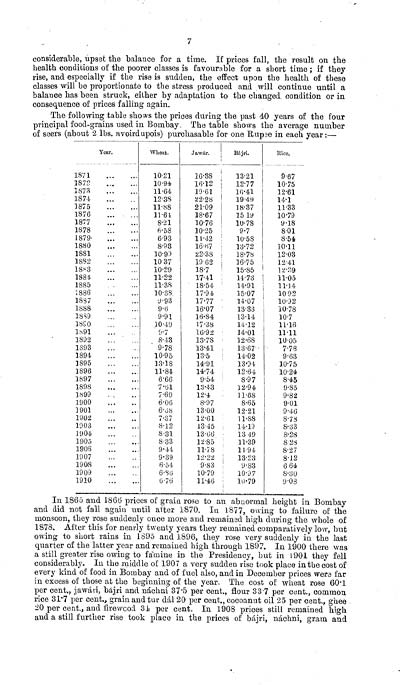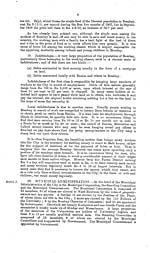Medicine - Disease > Report of an investigation into the causes of malaria in Bombay and the measures necessary for its control
(30) Page 7
Download files
Individual page:
Thumbnail gallery: Grid view | List view

7
considerable, upset the balance for a time. If prices fall, the result on the
health conditions of the poorer classes is favourable for a short time ; if they
rise, and especially if the rise is sudden, the effect upon the health of these
classes will be proportionate to the stress produced and will continue until a
balance has been struck, either by adaptation to the changed condition or in
consequence of prices falling again.
The following table shows the prices during the past 40 years of the four
principal food-grains used in Bombay. The table shows the average number
of seers (about 2 lbs. avoirdupois) purchasable for one Rupee in each year:-
Year.
Wheat.
Jawr.
Bjri.
Rice.
1871
10.21
16.38
13.21
9.67
1872
10.94
16.12
12.77
10.75
1873
11.64
19.61
16.41
12.61
1874
12.38
22.28
19.49
14.1
1875
11.88
21.09
18.37
11.33
1876
11.64
18.67
15.19
10.79
1877
8.21
10.76
10.78
9.18
1878
6.58
10.25
97
8.01
1879
6.93
11.42
10.58
8.54
1880
8.93
16.67
13.72
10.11
1881
10.99
22.38
18.78
12.03
1882
10.37
19.62
16.75
12.41
1883
10.29
18.7
15.85
12.29
1884
11.22
17.41
14.73
11.05
1885
11.38
18.54
14.91
11.14
1886
10.38
17.94
15.07
10.92
1887
9.93
17.77
14.07
10.92
1888
9.6
16.07
13.33
10.78
1889
9.91
16.84
13.14
10.7
1890
10.49
17.38
14.12
11.16
1891
9.7
16.92
14.01
11.11
1892
8.43
13.78
12.68
10.05
1893
9.78
13.41
13.67
7.78
1894
10.95
13.5
14.02
9.63
1895
13.18
14.91
13.94
10.75
1896
11.84
14.74
12.64
10.24
1897
6.66
9.54
8.97
8.45
1898
7.61
13.43
12.94
9.85
1899
7.69
12.4
11.68
9.82
1900
6.06
8.97
8.65
9.01
1901
6.68
13.00
12.21
9.46
1902
7.37
12.61
11.88
8.78
1903
8.12
13.45
14.19
8.33
1904
8.31
13.66
13.49
8.28
1905
8.33
12.85
11.39
8.28
1906
9.44
11.78
11.94
8.27
1907
9.39
12.22
13.23
8.12
1908
6.54
9.83
9.83
6 64
1909
6.86
10.79
10.97
8.30
1910
6.76
11.46
10.79
9.08
In 1865 and 1860 prices of grain rose to an abnormal height in Bombay
and did not fall again until alter 1870. In 1877, owing to failure of the
monsoon, they rose suddenly once more and remained high during the whole of
1878. After this for nearly twenty years they remained comparatively low, but
owing to short rains in 1895 and 1896, they rose very suddenly in the last
quarter of the latter year and remained high through 1897. In 1900 there was
a still greater rise owing to famine in the Presidency, but in 1901 they fell
considerably. In the middle of 1907 a very sudden rise took place in the cost of
every kind of food in Bombay and of fuel also, and in December prices were far
in excess of those at the beginning of the year. The cost of wheat rose 60.1
per cent., jawri, bjri and nchni 37.5 per cent., flour 33.7 per cent., common
rice 31.7 per cent., grain and tur dl 20 per cent., cocoanut oil 25 per cent., ghee
20 per cent., and firewood 31 per cent. In 1908 prices still remained high
and a still further rise took place in the prices of bjri, nchni, gram and
considerable, upset the balance for a time. If prices fall, the result on the
health conditions of the poorer classes is favourable for a short time ; if they
rise, and especially if the rise is sudden, the effect upon the health of these
classes will be proportionate to the stress produced and will continue until a
balance has been struck, either by adaptation to the changed condition or in
consequence of prices falling again.
The following table shows the prices during the past 40 years of the four
principal food-grains used in Bombay. The table shows the average number
of seers (about 2 lbs. avoirdupois) purchasable for one Rupee in each year:-
Year.
Wheat.
Jawr.
Bjri.
Rice.
1871
10.21
16.38
13.21
9.67
1872
10.94
16.12
12.77
10.75
1873
11.64
19.61
16.41
12.61
1874
12.38
22.28
19.49
14.1
1875
11.88
21.09
18.37
11.33
1876
11.64
18.67
15.19
10.79
1877
8.21
10.76
10.78
9.18
1878
6.58
10.25
97
8.01
1879
6.93
11.42
10.58
8.54
1880
8.93
16.67
13.72
10.11
1881
10.99
22.38
18.78
12.03
1882
10.37
19.62
16.75
12.41
1883
10.29
18.7
15.85
12.29
1884
11.22
17.41
14.73
11.05
1885
11.38
18.54
14.91
11.14
1886
10.38
17.94
15.07
10.92
1887
9.93
17.77
14.07
10.92
1888
9.6
16.07
13.33
10.78
1889
9.91
16.84
13.14
10.7
1890
10.49
17.38
14.12
11.16
1891
9.7
16.92
14.01
11.11
1892
8.43
13.78
12.68
10.05
1893
9.78
13.41
13.67
7.78
1894
10.95
13.5
14.02
9.63
1895
13.18
14.91
13.94
10.75
1896
11.84
14.74
12.64
10.24
1897
6.66
9.54
8.97
8.45
1898
7.61
13.43
12.94
9.85
1899
7.69
12.4
11.68
9.82
1900
6.06
8.97
8.65
9.01
1901
6.68
13.00
12.21
9.46
1902
7.37
12.61
11.88
8.78
1903
8.12
13.45
14.19
8.33
1904
8.31
13.66
13.49
8.28
1905
8.33
12.85
11.39
8.28
1906
9.44
11.78
11.94
8.27
1907
9.39
12.22
13.23
8.12
1908
6.54
9.83
9.83
6 64
1909
6.86
10.79
10.97
8.30
1910
6.76
11.46
10.79
9.08
In 1865 and 1860 prices of grain rose to an abnormal height in Bombay
and did not fall again until alter 1870. In 1877, owing to failure of the
monsoon, they rose suddenly once more and remained high during the whole of
1878. After this for nearly twenty years they remained comparatively low, but
owing to short rains in 1895 and 1896, they rose very suddenly in the last
quarter of the latter year and remained high through 1897. In 1900 there was
a still greater rise owing to famine in the Presidency, but in 1901 they fell
considerably. In the middle of 1907 a very sudden rise took place in the cost of
every kind of food in Bombay and of fuel also, and in December prices were far
in excess of those at the beginning of the year. The cost of wheat rose 60.1
per cent., jawri, bjri and nchni 37.5 per cent., flour 33.7 per cent., common
rice 31.7 per cent., grain and tur dl 20 per cent., cocoanut oil 25 per cent., ghee
20 per cent., and firewood 31 per cent. In 1908 prices still remained high
and a still further rise took place in the prices of bjri, nchni, gram and
Set display mode to: Large image | Zoom image | Transcription
Images and transcriptions on this page, including medium image downloads, may be used under the Creative Commons Attribution 4.0 International Licence unless otherwise stated. ![]()
| India Papers > Medicine - Disease > Report of an investigation into the causes of malaria in Bombay and the measures necessary for its control > (30) Page 7 |
|---|
| Permanent URL | https://digital.nls.uk/74573056 |
|---|




